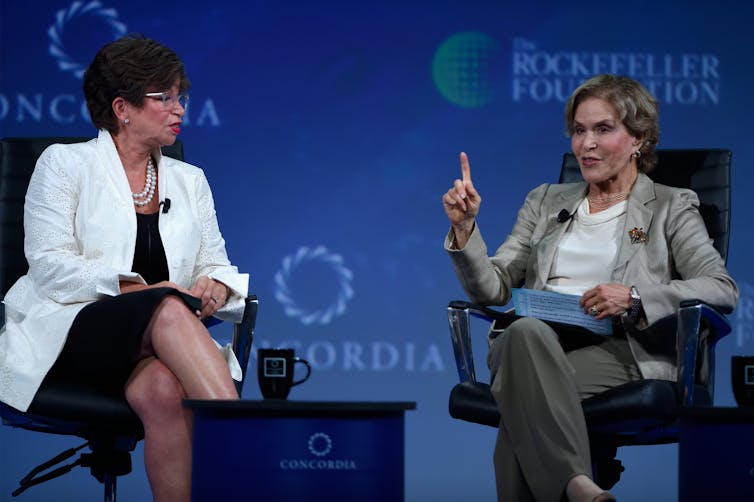6 of 8 Ivy Leagues will soon have women as presidents — an expert explains why this matters
Despite what’s happening on the most prestigious campuses, fewer than a third of presidents at American colleges and universities are women.

For the first time, a majority of Ivy League schools will soon be led by women.
Starting July 1, 2023, Claudine Gay will assume the role of president at Harvard University, Nemat “Minouche” Shafik at Columbia University and Sian Leah Beilock at Dartmouth College. They will join current female presidents at Brown University, Cornell University and University of Pennsylvania.
Felecia Commodore, an associate professor of higher education at Old Dominion University, explains what this means for gender equity in the college presidency – and why U.S. colleges and universities still have a long way to go.
Why does this matter?
While women make up about 60% of undergraduate as well as master’s and doctoral students in the U.S., only about 32% of presidents of American colleges and universities are women.
However, the Ivy League is not new to selecting female presidents – they have been doing so for a few decades. Judith Rodin was the first, in 1994, when she became president of the University of Pennsylvania. She was followed by Ruth Simmons at Brown University and Shirley Tilghman at Princeton University, both in 2001. Rodin was succeeded by another woman, Amy Guttman, in 2004.
Still, one reason this moment may be one to watch is that Ivy League institutions are often seen as exemplars of elite, complex institutions. So seeing what one could consider a critical mass of female leaders in the Ivy League could signal the benefit of women in leadership to other boards that are hesitant or slow to hire women as presidents.
How unusual is this across higher ed?
I think it would be more surprising to see mostly female presidents at the majority of large public research universities, or at a majority of the schools in the Power 5 athletic conferences.
Despite what may seem like a boom in women leading institutions, the percentage of women in the presidency at colleges and universities more broadly has plateaued at between 25% and 30% for the past decade. This was after increasing from 9.5% in 1986 to 19% in 1998.
A number of factors contribute to this low percentage, including barriers within the college presidential pipeline – such as exclusion from networks that provide mentorship – reward and promotion structures that are not equitable across genders, and bias against women in academic leadership roles.
A recent analysis of data on college presidents explains how this bias against women occurs, specifically when it comes to academic leadership roles. This is important because college presidents typically find their way to the presidency through academic leadership roles such as deans, vice provosts and provosts.

What are the biggest challenges that college presidents face?
The biggest priority or challenge really depends on the individual college or university. However, all institutions must ensure they are financially healthy and identify opportunities to strengthen their financial resources. College presidents have reported that they spend the most time on budget and financial management, followed by fundraising.
Particularly in the current higher education marketplace, where the average cost of college runs over US$35,000 per year, college leaders must work to keep their institutions fiscally strong and also competitive and affordable. This may involve, for example, building new infrastructure, creating new programs and cultivating new sources of funding.
What effect does having a woman in the top seat have?
For colleges that have only ever had a man in the president’s role, hiring their first woman as president can signal that the institution embraces change and evolution. This can be an especially important message to send to funders, alumni donors, philanthropists, state legislators and corporate partners, who all play a role in ensuring a particular college’s financial vitality.
Female presidents add to the diversity of the college presidency. They add different perspectives to conversations that shape practices and policies both within their college and across higher education. They might, for example, provide their particular perspective regarding compensation for female faculty members of color, who tend to engage in more unpaid service work on campuses.
Organizational scholars and business leaders affirm that diversity strengthens the decisions made by organizations and contributes to innovative solutions. A more diverse group of decision-makers can generate more decision alternatives than a homogeneous group that may be susceptible to group think.
And lastly, having women at the helm of academic institutions shows other women who aspire to become college presidents that it is indeed possible.
Felecia Commodore does not work for, consult, own shares in or receive funding from any company or organization that would benefit from this article, and has disclosed no relevant affiliations beyond their academic appointment.
Read These Next
From truce in the trenches to cocktails at the consulate: How Christmas diplomacy seeks to exploit s
World leaders like to talk up peace at Christmastime. But alongside the tales of seasonal breaks in…
As DOJ begins to release Epstein files, his many victims deserve more attention than the powerful me
Powerful men connected to Jeffrey Epstein are named, dissected and speculated about. The survivors,…
The world risks forgetting one of humanity’s greatest triumphs as polio nears global eradication − 7
Polio may finally be defeated in the next 5 years. Will the world recognize what an extraordinary achievement…






